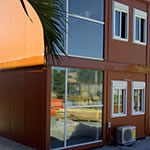After the 2010 earthquake in Haiti destroyed the country’s Ministry of Public Health and Population in Port-Au-Prince, it needed a new home—fast. “The earthquake forced health officials to work out of temporary housing or tents, and there was no place to conduct research and do training,” says John Keller, president of Proteus Design Company, an Austell, Georgia, provider of semipermanent facilities that stepped in after the earthquake. “The Center for Disease Control Foundation had heard about work we had done in Port-Au-Prince, quickly creating turnkey semipermanent offices for the Haiti government, and contacted us.”
The project consisted of two structures: a one-story building to house the Haitian minister of health and her direct staff and a two-story building that would be shared by staff from the CDC and the Haitian National Laboratory. Because the second building would be shared by CDC staff, it had to comply with special workplace requirements for US government personnel working abroad.
Proteus Design used its Flex System on the project, which is a modular building system comprising fully insulated structural steel that can be reconfigured to meet the needs of many clients. In this case, the buildings were fitted with all facilities, furniture, and IT and communications infrastructure and were made to be earthquake- and hurricane-resistant. The structures were completed in just five weeks.
 This short time frame is not unusual for Proteus Design, and its Flex System was designed with that in mind. Units can be seamlessly integrated horizontally or vertically to create two- or three-story buildings, and the standard fiberglass exterior can be finished to incorporate any color or material, including stone, stucco, steel, glass, and wood. The Flex System is 100 percent relocatable, reusable, and repurposable.
This short time frame is not unusual for Proteus Design, and its Flex System was designed with that in mind. Units can be seamlessly integrated horizontally or vertically to create two- or three-story buildings, and the standard fiberglass exterior can be finished to incorporate any color or material, including stone, stucco, steel, glass, and wood. The Flex System is 100 percent relocatable, reusable, and repurposable.
The system stems from Proteus Design’s original business plan when it was founded in 1996, which was to create semipermanent facilities to ease the overcrowding of schools and jails and to do it quickly. “We wanted to produce a product or system that would be engineered to be removed and reconstituted or recombined in different forms,” Keller says.
Today, the company is also seeing business from airports, offices, and even stores, but one thing has remained consistent—the company considers itself a service provider more than a product provider. “If we only used tents, we’d be a tent company, but that doesn’t make sense because different projects have different physical constraints, different aesthetic requirements, etc.,” Keller says, meaning Proteus Design’s projects can incorporate several types of building systems. “We use knock-downs, aluminum, inflatables, steel, and fabric to achieve the client’s project goals quickly and on budget.”
The company’s work is complex, requiring the support of companies such as M3 Crane, which supplies Proteus Design with cranes, manpower, and rigging, and assists in the assembly of its solutions. “Proteus’s field personnel are accommodating and proactive in organizing the locations of the cranes we supply them, which is complicated and sensitive work,” says Michael Foggio, president of M3 Crane “Proteus demonstrates the utmost professionalism and is a pleasure to work with.”
Keller says the modular concept plays out differently across continents. “When you do project launches or exhibitions in the United States, you tour around making dozens of stops, so you need solutions that are easily mobilized and demobilized by being wheeled,” he says. “Europe is much denser, and exhibitors tend to bring people from around Europe to a single location be that in Paris or Amsterdam, so temporary facility solutions are often more complex and can be built vertically via stacking as opposed to rolling.”

